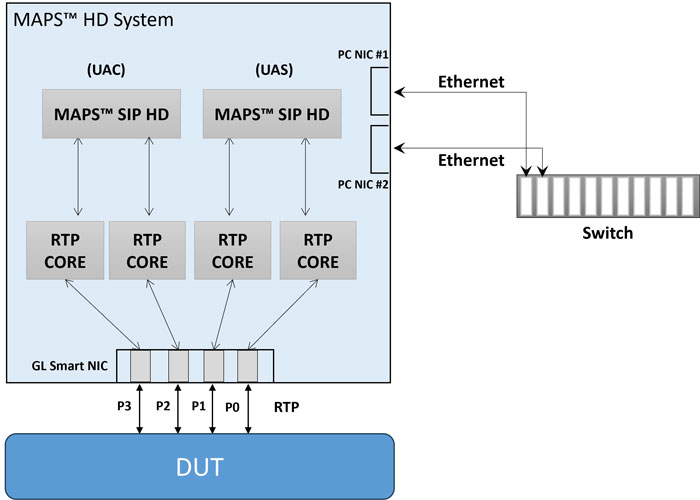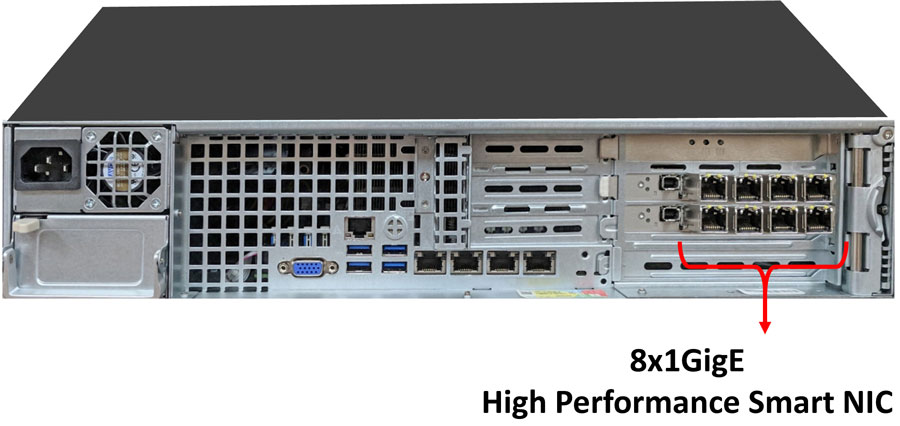High-Density RTP Traffic Generator and Simulator for IP & Wireless Networks
Bulk RTP traffic generator designed for intensive signaling and traffic generation over IP and Wireless networks.
Request a Demo / Quote BrochureOverview
Wireless carriers, internet service providers and equipment vendors must ensure that their services and products can sustain high performance when subject to large call volumes. Load and stress testing are important to verify the stability of IP networks and network elements pre- and post-deployment.
MAPS™ (Message Automation and Protocol Simulation) is GL’s standard framework for emulation of IP, TDM, and Wireless protocols.
The network appliance performs signaling and traffic generation for a vast array of communication protocols covering IP and Wireless networks. With additional licensing, MAPS™ High Density RTP can support simulation of SIP (PKS120), GSM A (PKS137), BICC (PKS155), MGCP, H.248/MEGACO (PKS122), and provides non-reference based voice quality using E-model (R-factor) and MOS with five mapping scales.
MAPS™ High Density network appliance is designed to easily achieve up to 160,000 simultaneous calls per appliance. Using a stack of multiple servers, a larger test system with 8000K-1000K calls is achievable for enterprise to carrier grade testing.
The network appliance provides a modular and flexible solution to generate real voice calls using industry standard voice codecs such as G.711 A/µ-law, G.722, G.722.2 (AMR-WB), G.722.1, G.726, G.729A/B, GSM (EFR, FR and HR), AMR (Narrowband and Wideband), EVRC, EVRCB, EVRC-C, iLBC, Speex, SpeexWB, EVS, OPUS and RFC 2833/4733-out of band events.
MAPS™ High Density (HD) RTP
MAPS™ HD RTP (PKS109) is an advanced bulk RTP media generator used to emulate high volume calls (using the various optional signaling emulator software) with RTP traffic. It is available as special purpose rackmount/lunchbox network appliance with 4x1/10 GigE or 8x1/10 GigE network interface cards capable of high call intensity (hundreds of calls/sec) and high volume of sustained calls (tens of thousands of simultaneous calls/platform) for RTP media.
MAPS™ HD System Setup
The 2 regular PC NICs are connected to a managed switch using Ethernet cables as shown below. The four ports on GL’s HD NIC card are connected to a Device Under Test (DUT).

MAPS™ HD Characteristics:
- Signaling calls can be transmitted over UDP and TCP, IPv4 and IPv6, and TLS for secure transport
- RTP media is transmitted over UDP with IPv4 or IPv6 address
- Unique endpoint emulation using IP address, MAC address, and VLAN tagging
- Scales up to 160,000 simultaneous calls for each appliance (8x 10G) with duplex RTP traffic
- Achieve up to 800 calls per second (with RTP traffic)
- Multiple units can be stacked to emulate approximately 800,000 to 1,000,000 user endpoints
- Manage 10+ MAPS™ systems with single point of control from Master Controller
- Simulate various traffic conditions to measure the performance of a network element
- Simulate complete protocol state machine to troubleshoot the network issues
- Powerful load generation, scheduling and command line interface for automation, remote control and load testing
- Configurations, test scripts, and profiles can be saved and reused on a different systems
- Easy-to-use scripting interface for creating test scripts
- User can modify signaling messages, message parameters, and/or information elements
- Packet level fault insertion
- Real-time monitoring and reporting of registration and call statistics
- Statistics can be viewed on any pair of endpoints
- Export data to other applications for customized user report
Applications
MAPS™ HD has many applications including:
- Pre- and post-deployment testing of enterprise, ISP, and Carrier Networks
- Evaluate quality of experience as a function of signaling or traffic load or protocol variation
- Networks Applications for IP, Mobile Broadband, SIP, IMS, Wireless
- Quality of Service (QoS) for voice
- End-to-End testing of complex networks like Next Generation Voice Networks, Unified Communications, and IMS & Contact Centers
- Contact Center and Unified Communications
- Interactive Voice Response System (IVR), Automatic Call Distributor (ACD), routing, Computer Telephony Integration (CTI), CRM, chat, presence, conferencing, speech, and agent desktop applications
- Security
- Denial of Service, Theft of Service, traffic floods, intrusion prevention, firewalls, intrusion detection systems, and security gateways
- Network elements
- Session border controllers, network border elements, application level gateways and deep packet inspection devices, and intrusion prevention/intrusion detection systems
- Automated Tests
- Load generation can test maximum active call handling capacity, busy hour call attempts, and calls attempted by the simulator at one shot (burst)
- Stress testing can check for out-of-boundary conditions.
- Automate regression tests
Resources
Note: PCs which include GL hardware/software require Intel or AMD processors for compliance.
Please Note: The XX in the Item No. refers to the hardware platform, listed at the bottom of the Buyer's Guide, which the software will be running on. Therefore, XX can either be ETA or EEA (Octal/Quad Boards), PTA or PEA (tProbe Units), XUT or XUE (Dual PCIe Express) depending upon the hardware.
| Item No. | Description |
| PKS109 | MAPS™ High Density RTP Generator |



